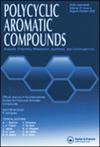氨基磺酸支撑的 Zr-MOF:一步合成新型 6-氨基-5-(4-氨基-2-氧代-2H-色烯)类似物的有效催化剂
IF 2.4
3区 化学
Q2 CHEMISTRY, ORGANIC
引用次数: 0
摘要
利用氨基磺酸功能化 Zr-MOF-NH2 作为活性酸性金属有机框架催化剂,通过 2-羟基-5-(芳基二氮基)苯甲醛、4-氨基古柯碱和 6-氨基-1,3-二甲基脲嘧啶或 6-氨基脲嘧啶在 EtOH 中的一步反应,在回流条件下合成了新的 6-氨基-5-(4-氨基-2-氧代-2H-Chromen) (AAOC) 类似物。通过采用不同类型的光谱技术,如 XRD、BET、FESEM、EDS、FT-IR 和 TGA,对得到的 UiO-66-NHSO3H 进行了表征。此外,该方法还具有操作简便、反应时间短、催化剂可回收且催化活性不会发生太大变化等优点。本文章由计算机程序翻译,如有差异,请以英文原文为准。
Sulfamic Acid Supported Zr-MOF: An Effective Catalyst for One-Step Synthesis of Novel 6-Amino-5-(4-Amino-2-Oxo-2H-Chromen) Analogs
Sulfamic acid-functionalized Zr-MOF-NH2 was used as an active acidic metal-organic framework catalyst for the synthesis of new 6-amino-5-(4-amino-2-oxo-2H-chromen) (AAOC) analogs via a one-step reaction between 2-hydroxy-5-(aryldiazenyl)benzaldehyde, 4-aminocumarin, and 6-amino-1,3-dimethyluracil or 6-amino-uracil in EtOH under reflux conditions. The resulting UiO-66-NHSO3H was characterized by employing different types of spectroscopic techniques such as XRD, BET, FESEM, EDS, FT-IR, and TGA. In addition, ease of procedure, short reaction time, and recycling of the catalyst without much change in the catalytic activity are the advantages of this method.
求助全文
通过发布文献求助,成功后即可免费获取论文全文。
去求助
来源期刊

Polycyclic Aromatic Compounds
化学-有机化学
CiteScore
3.70
自引率
20.80%
发文量
412
审稿时长
3 months
期刊介绍:
The purpose of Polycyclic Aromatic Compounds is to provide an international and interdisciplinary forum for all aspects of research related to polycyclic aromatic compounds (PAC). Topics range from fundamental research in chemistry (including synthetic and theoretical chemistry) and physics (including astrophysics), as well as thermodynamics, spectroscopy, analytical methods, and biology to applied studies in environmental science, biochemistry, toxicology, and industry. Polycyclic Aromatic Compounds has an outstanding Editorial Board and offers a rapid and efficient peer review process, as well as a flexible open access policy.
 求助内容:
求助内容: 应助结果提醒方式:
应助结果提醒方式:


